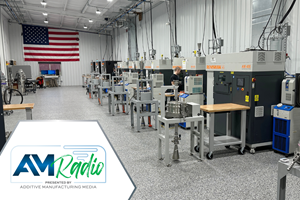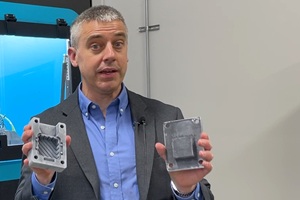BPMI Chooses Velo3D Metal 3D Printing System to Produce Parts for U.S. Naval Nuclear Propulsion Program
The fully integrated 3D printing solution will be operated by ATI in a newly established facility that will provide the U.S. Naval Nuclear Propulsion Program with alternatives to cast parts.
A Velo3D large-format Sapphire XC Hero HR TX. BPMI has chosen a Sapphire XC to be operated by ATI in a new Florida facility that supports the U.S. Navy. Source: Velo3D
Bechtel Plant Machinery Inc. (BPMI) has selected a fully integrated metal additive manufacturing solution from Velo3D to produce parts for the U.S. Naval Nuclear Propulsion Program. The Sapphire XC large format printer, calibrated for stainless steel 415, will be operated by ATI at its new additive manufacturing (AM) facility outside Fort Lauderdale, Florida.
Earlier this year, BPMI awarded a contract to ATI to support development of highly engineered part solutions for advanced manufacturing methods including metal AM. The partners will use the printer to produce parts previously produced through casting, reducing lead times for mission-critical parts and streamlining its supply chain.
Velo3D’s technology was developed in the U.S. and includes a fully integrated software and hardware solution. According to the company, some conventional 3D printers often struggle to produce parts with overhanging features beyond 45 degrees without support structures. However, Velo3D’s technology offers the ability to produce parts with a wide variety of geometries with few to no supports.
This has enabled the company to address applications that other 3D printing technologies cannot. In addition to using this technology to 3D print parts that are traditionally cast, Velo3D says its technology also enables more innovative designs to replace components currently in use. This capability can be scaled to additional machines across multiple locations and operators.
“BPMI and ATI’s progressive approach to 3D printing is extremely forward-thinking and this new, revolutionary facility will significantly augment the U.S. Navy’s supply chain for maintenance, repair and operations,” says Brad Kreger, Velo3D CEO. “Both companies are early adopters of metal 3D printing and innovators in the manufacturing industry. We look forward to working with them as they support the U.S. Navy’s fleet, including its aging vessels.”
The U.S. Navy currently operates approximately 300 vessels, many of which were commissioned decades ago. They, along with the broader U.S. Department of Defense, have actively incorporated AM, acknowledging its efficiency in supporting its aging equipment, enhancing warfighter readiness and reducing replacement part lead times. AM accomplishes this by enabling distributed supply chains and digital inventories where manufacturers can produce parts within spec across any similar printer calibrated for the same metal alloy. It is said that ATI’s new secure facility, along with Velo3D’s fully integrated solution, are significant steps forward in advancing the Navy’s maintenance and operational capabilities.
“Printers with larger build volumes and the ability to print with less support structures are ideal for U.S. Naval Nuclear Propulsion Program applications,” says Nathan Weiderspahn, BPMI executive manager, Industrial Base Management. “This additive manufacturing technology will greatly support our efforts in delivering new technology to the U.S. Navy and helping maintain its fleet of ships.”
ATI will be able to more easily additively produce complex parts with fewer support structures, at lower angles and larger sizes than ever before. “This enables us to broaden the scope of possible part designs for our defense and aerospace customers, enabling higher performance and better quality,” says Joe Thompson, general manager of ATI Additive Manufacturing Products. “The business opportunity represented by these previously unproduceable part designs is significant.”
BPMI’s new Sapphire XC printer is the first such printer from Velo3D calibrated for stainless steel 415, an alloy of iron, chromium and nickel that provides good tensile strength and corrosion resistance at a range of temperatures.
Related Content
Additive Enhances Lost Foam Casting Process for Metal Manufacturing
Skuld LLC brings a new, 3D printing-enabled version of lost foam casting to market via its turnkey package for metal manufacturers. Additive Manufacturing Evaporative Casting (AMEC) enables metal parts made with sustainability and efficiency in mind.
Read MoreSouthern Indiana’s Thriving AM Part Producer — What I Saw at Innovative 3D Manufacturing: AM Radio #49
Recorded just after the visit to the laser powder bed fusion contract manufacturer, here is a conversation exploring observations and impressions of this company and its metal 3D printing work.
Read MoreIn Casting and Molding, AM Simplifies Conventional Manufacturing
In new ways, additive processes are streamlining and enabling metal casting and plastic injection molding.
Read MoreNew Equipment, Additive Manufacturing for Casting Replacement and AM's Next Phase at IMTS 2024: AM Radio #54
Additive manufacturing’s presence at IMTS – The International Manufacturing Technology Show revealed trends in technology as well as how 3D printing is being applied today and where it will be tomorrow. Peter Zelinski and I share observations from the show on this episode of AM Radio.
Read MoreRead Next
Profilometry-Based Indentation Plastometry (PIP) as an Alternative to Standard Tensile Testing
UK-based Plastometrex offers a benchtop testing device utilizing PIP to quickly and easily analyze the yield strength, tensile strength and uniform elongation of samples and even printed parts. The solution is particularly useful for additive manufacturing.
Read MoreAlquist 3D Looks Toward a Carbon-Sequestering Future with 3D Printed Infrastructure
The Colorado startup aims to reduce the carbon footprint of new buildings, homes and city infrastructure with robotic 3D printing and a specialized geopolymer material.
Read More3D Printed Polymer EOAT Increases Safety of Cobots
Contract manufacturer Anubis 3D applies polymer 3D printing processes to manufacture cobot tooling that is lightweight, smooth and safer for human interaction.
Read More





















